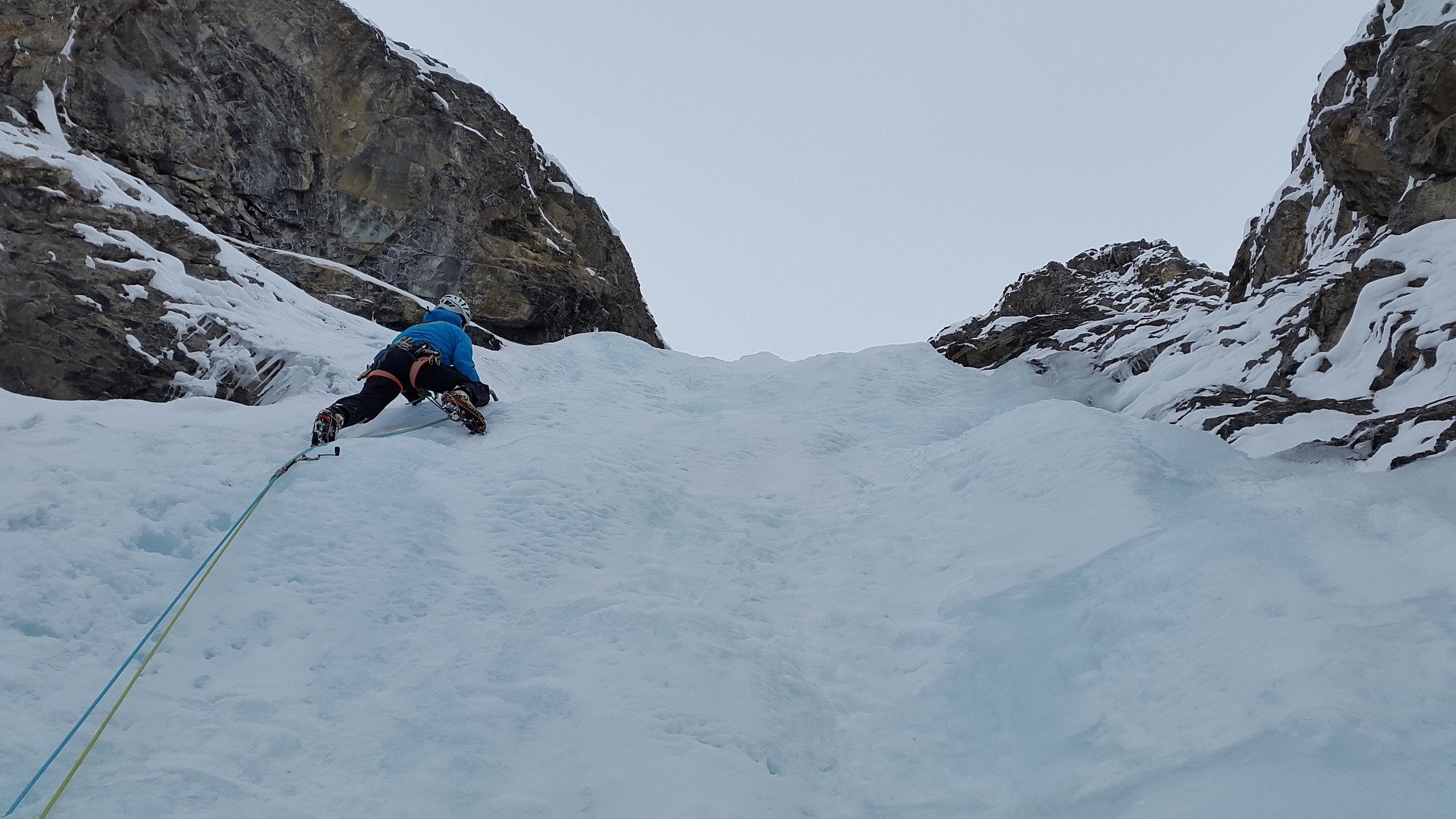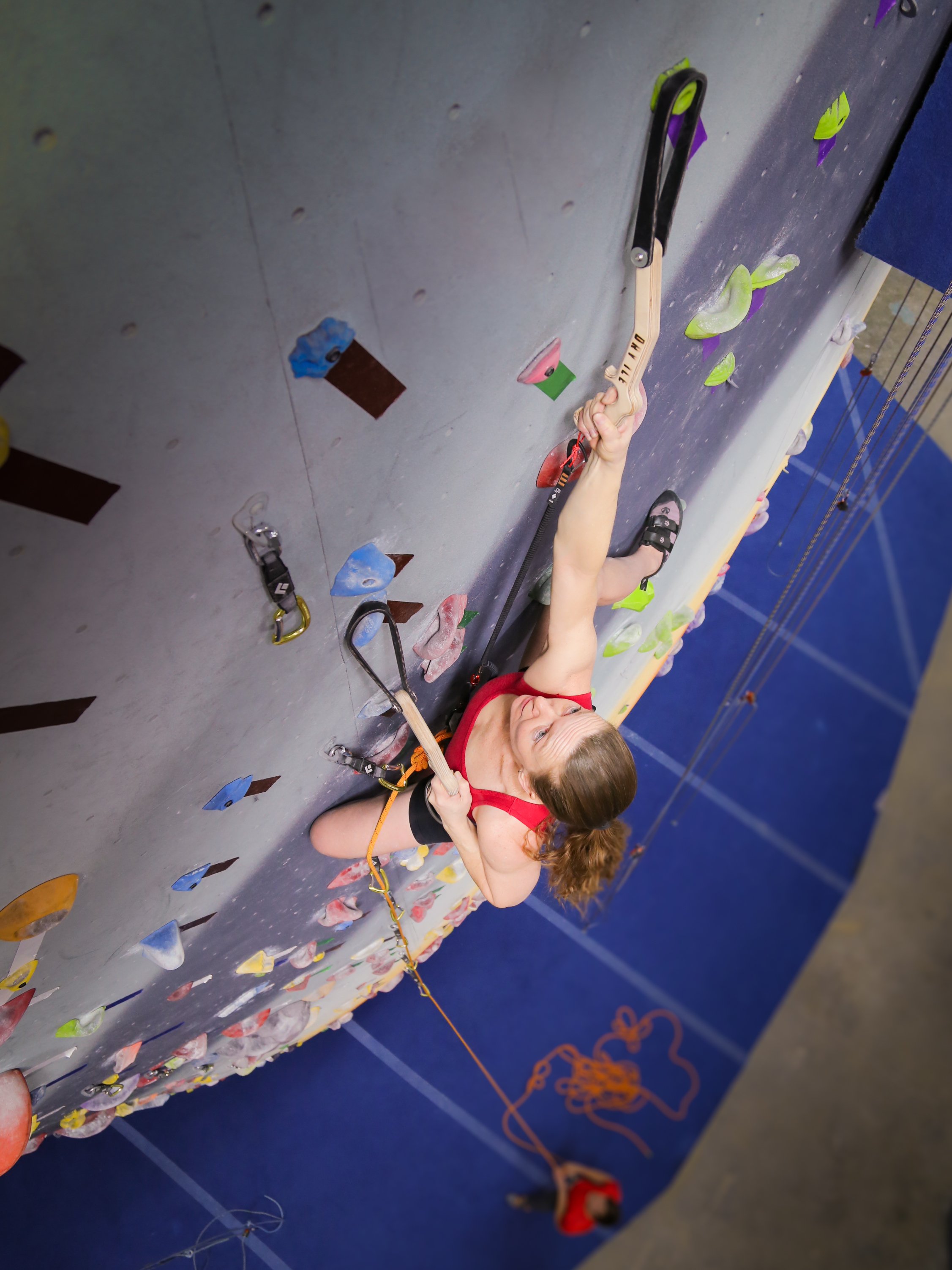Training For Ice Climbing and Dry Tooling:
Head Games
This post is part of a series on Training For Ice Climbing and Dry Tooling. Click below for sequential posts:
Build a Solid Foundation
Fortification
Basic Core
Hard Core
Endurance
Special Techniques
Head Games
Taking It Outside
Long routes require deep mental reserves.
You’re doing:
Foundation with Fortification
Hard Core
Endurance
Special Techniques
Head Games
Alpine start. Coffee. 45 min drive to the trailhead. Opening the car door to icy cold slap in the face. Breathy headlamps on. 1.5 hrs uphill avalanche prone gully approach to the route. Packs off below the ice flow, the sun has just begun to turn the sky from soft black to inky azure. Geared up. Ropes flaked. Temps -10°C. You are cold, but somehow sweating, Fingers and toes numb but not hurting. Sound of the water running inside the ice. Look up, it’s steep, dead vertical with crazy blobby overhanging sections high up. 200m snow slope below is exactly 30° followed but a short cliff into the drainage. Tied in. Screws racked. On belay. Swing a tool into the ice and hear the hollow thunk of a ‘maybe-it’s-good’ placement. Swing again. Doubts arise. Is it bonded well? How have the temps been? Are my crampons on the right feet? Butterflies in your stomach. What am I doing here?! Wait, what?. The tip protectors are still on my screws. This looks scary. Why won’t my hands warm up? It’s starting to snow...
Dangerous Liaisons
Ice Climbing is not for the meek. It is incredibly dangerous with extremely high probability of injury during even the shortest of leader falls. For those who are game for lead climbing ice or mixed routes, there’s nothing more consuming of one’s focus or demanding of one’s skills, ‘cept maybe motorcycle racing, or boxing. The technical and physical parts are easy to learn and prepare. The mental game is not.
The Mental Game
Even with the extreme risks, Ice, Mixed, and Dry Tool Climbing offer an incredibly rewarding experience that reinforces a deep confidence in one’s self sufficiency. This type of climbing requires the leader to look deep within. You are quite literally climbing something that will fall down someday. You have to know when you can do it, and when you can’t. You must know when the risks are too much, when to walk away. Risk management is paramount.
Be honest about what you know and what you do not. That level of conservative confidence develops from a long climbing apprenticeship, from mistakes made and lessons learned. From keeping eyes open and senses alert in the mountains. From seeking qualified instruction such as guided skills courses, avalanche training, lead clinics at ice fests, reading, watching, training in the gym with DRY ICE Evolutions. From repeatedly experiencing how your body reacts under extreme physical stress. From knowing how your head performs under extreme mental stress.
Below is just one approach to training your mind to deal with the existential one-two punch that ice climbers take on the chin.
Mental Training
NOT FLYING? NOT TRYING.
In the gym, get into the ‘red zone’. This means climbing past your ability and really spending time in the zone where you feel like you’re coming off and are indeed coming off. Get there, stay there, and be there as long as you can. You are going to fall so do this with caution. Do it on lead. Breathe through it. Soak it in.
Notice what happens to:
-Your breathing - Fast? Slow? Controlled? Short? Deep?
-Your forearms - Flaming? Comfortable? Are you managing the pump by switching hands?
-Your shoulders - Are your shoulders choking up as your grip strength wanes?
-Your arm position - Are you bending your elbows instead of hanging with straight arms?
-Your footwork - What are you feet doing?
Then, notice what your mind is doing. There will be a lot of noise in there. Take a moment, rise above it in your head and hear it. Are you hearing “oh shit, oh shit, oh shit”? Are you telling yourself, “I can’t”? Is there something saying, “There’s just no way”?, "I Suck.” Write these things down. See them on the paper, then write the opposite. “I got this”, “I can”. “I can figure out a way.” “I am climbing very hard and very safely.’
Do this every time you workout your mind on a climb. The longer you spend in the red zone, the more you’ll learn about what you’re telling yourself and how your mind behaves in that space. Close your eyes and listen to yourself. Do NOT try to fix it, simply become aware of it. Once you can settle down and give that voice the attention it’s demanding, it will simply quiet down, dissipate into the background. This is because you are not those thoughts. You are the observer of those thoughts. You will push past previous failure points once you realize that you, in fact, are your own worst enemy.
Let Go.
Two monks were traveling together. At one point, they came to a river with a strong current. As the monks were preparing to cross the river, they saw a very young and beautiful woman also attempting to cross. The young woman asked if they could help her cross to the other side.
The two monks glanced at one another. They had taken vows not to touch a woman.
Without a word, the older monk picked up the woman, carried her across the river, placed her gently on the other side, and carried on his journey.
The younger monk couldn’t believe what had just happened. After rejoining his companion, he was speechless, and an hour passed without a word between them.
Two more hours passed, then three, finally the younger monk could not contain himself any longer, and blurted out “As monks, we are not permitted to touch a woman, how could you then carry that woman on your shoulders?”
The older monk looked at him and replied, “Brother, I set her down hours ago, why are you still carrying her?”
Ice Climbing and especially Mixed Climbing are excellent at pushing unnecessary thoughts out of your head. But sometimes there’s that thing that just lingers on the mind. Going through a rough breakup? Angry at something at work? Did someone cut you off in traffic and is that frustration festering? Events like these can pull focus away from the serious task at hand. Three deep breaths. Let go. Be present. Go climb.
Other Notes to Quiet the Mind
Stoke the fire. It is so cold outside that a torrent of falling water has frozen in place. Your body is 98% water. If you’re cold, your mental focus is not where it needs to be. What was the last thing you ate or drank? To climb at your best your mind requires you to feed the fire to keep warm in the winter environment. Plan your food for the day to maintain body temperature and energy level. Fill up a vacuum bottle with hot drinks. Drink hot tea at the belays. Bring a puffy jacket and use it. Eat high fat, high calorie food like jerky, peanuts, and chocolate. Ice climbing is no place for healthy snacks. You’ll be happier and your lead head will remain intact.
Know Thyself
More than just an ancient directive handed down from the Greeks, be honest about your failings with yourself and with your partner. While assessing Objective Hazards, know that it’s Subjective Hazards that more often than not lead to accidents. Get good at assessing risks, divorcing your desires from potentially unreasonable risk. This is not Point Break. There is precisely zero shame in walking away. The only bruise will be to your quickly-healed ego.
Additional Resources and Suggested reading:
Climbing Guide Dustin Portzline is one of the few guides out there (the only one we know of in fact) who specifically offers courses in mental training. Check out him and the course here.
The Rock Warrior’s Way by Arno Ilgner
This is THE climber’s mental training bible.
Zen Flesh Zen Bones by Paul Reps (Compiler) and Nyogen Senzaki (Compiler)
First published in 1957, this book became an instant sensation with an entire generation of readers who were just beginning to experiment with Zen. As climbers we can benefit from these lessons and tales collected over the past 5 centuries.
The Tao of Pooh by Benjamin Hoff
The unassuming bear to introduces us to Eastern philosophical principles. Pooh epitomizes the "uncarved block," as he is well in tune with his natural inner self.
Accidents in North American Climbing - The American Alpine Club
The year’s most significant and teachable climbing accidents. Learn from the mistakes of others.













